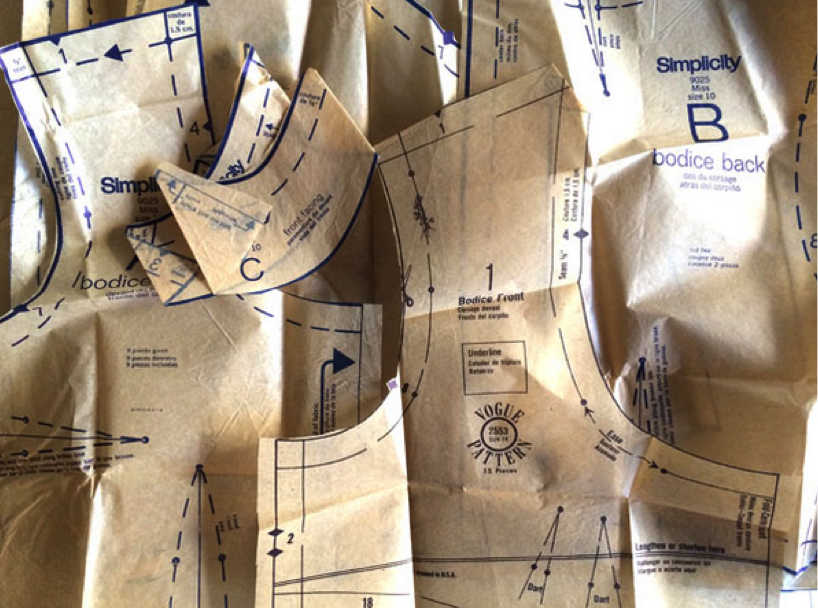As a lover of patterns and a fond advocate of Montessori education, I was always so happy to have my children show me the tessellations they produced as the pre-cursor to the more complex mathematical concepts the Montessori materials introduce. Beautifully tiled surfaces that repeated designs, trained their naive eyes to search out patterns and see the order and beauty in things. Seeing the symmetry in complex patterns alerted their brains to the possibilities of what could come next.
I also remember sitting bored into oblivion during Saturday morning shopping trips into the city with my mother and sister as they poured over enormous books that housed samples of patterns for clothes. They sat absorbed in the task, like monks working on the illuminations of religious manuscripts. They would finally choose a pattern; decode the requirements for zips, buttons and fabric lengths, select their materials and head home to create.
I’d watch my mother, her mouth porcupined with pins clenched between her lips as she pinned the pattern to her fabric. It was a fascination to see the flimsy paper being attached with careful precision so that every millimetre of fabric was used to maximum benefit. The design of the fabric needed to line up at seams and my mother somehow instinctively knew how to lay the paper on the straight grain, cross grain or the bias so the weft and warp of the threads would hang with decorum against my sister’s form.
She would then hum away at her Singer sewing machine and produce an ensemble that rivalled the boutiques of the day. I was always amazed that the outfit formed itself out of the deconstructed patterned pieces. I made model airplanes from plastic moulded forms and with sticky fingers would glue together the pre-made pieces to form German Junkers and British Spitfires that I would hang from my bedroom ceiling with fishing line freezing an enactment of World War aerial dogfights. But my model planes didn’t seem to have the same mysterious alchemy as turning paper patterns into fashion. I became aware of a more complex design at work.
As we have approached the end of term, again our family is plagued by tests and assignments that demarcate the midpoint of the semester. My son has a fascination for history and he spent hours time-lining the causes and battles of the Second World War. All the dates from the Treaty of Versailles to the emancipation of Auschwitz were memorised. We’d chat about the Night of the Broken Glass (Kristallnacht) and try to imagine what it must have felt like to watch the windows of all the Jewish merchants, homes and Synagogues being shattered. Did people know what this was going to signal? Could they see the signs of what was coming and did they know what the next best step could have been? Patterns often materialise with hindsight.
My daughter just celebrated her 18th birthday and I watch with admiration as I see her stepping into her adult life. I know she has a map for how she wants her life to traverse the tricky paths into the self-authorship of her destiny. I also know that life has a funny way of disregarding our plans and taking us into territories we never imagined we would have to navigate. Will she be able to read the signs? Have we done enough to teach her how to recognise the patterns for having a fulfilling life? Will she see the marks of a partner who will break her heart, a job that takes her nowhere, a choice that can leave her with heavy regrets? It’s one thing to creatively duplicate the patterns of coloured tiles in tessellated art, it’s quite another to know when to duplicate a pattern or cease it in order to lift your consciousness to a higher order and create the life you want.
Back when I was studying psychology and trying to make sense of my world, and myself I came across a definition of successful maturity as people who can ‘remain unambiguous in an ambiguous world’. Now, well past middle age, this definition seems to me, to be about people who are good a predicting issues and anticipating how they will shape their future. They understand the multi-dimensional complexity of cause and effect and the interdependence of a glut of variables. They are the people who can prepare for alternative realities and challenges and clearly interpret relevant opportunities. It’s the formidable pattern seers that own the future – the Kings and Queens of sense-making.
I think if you meet someone who confidently calls himself or herself a great sense-maker you’d have a clue you were chatting with a narcissist. Knowing when to fall down, when to get back up; when to step aside and when move forward – these are the real challenges in life. More importantly having someone else tell you about the patterns and opportunities to predict what comes next is of no use, because only you can know how you will fall down, get back up, step aside and move forward for your life.
Life has a way of upsetting our predictable patterns and formulas for who we are and how we need to be in the world. If there was a perfect formula someone in the world would have patented it and would be selling it online for just $39.95 a month. Many of us have a beautifully tenuous grip on our lives no matter how firmly we hold on to it. In the time it takes to exhale a sigh of relief, your life can pivot into a new trajectory for which you have no plan, little known preparation and very few recognizable patterns which you can overlay on your way.
Perhaps life asks of us a humbler approach. We can enjoy the art and science of sense-making that our brains afford us, but need to doff our spiritual cap at a force in life that has its own plans for our existence. As Joseph Campbell said, far more eloquently than I could, “We must let go of the life we have planned, so as to accept the one that is waiting for us.”
So my son learned that no matter how many dates and lists of events you squeeze into your brain, the exam question requires that you present the information in the way the marker wants to receive it. There’s a pattern in answering exams questions that is a different kind of knowledge. My daughter will explore and discover her inner vigour in order to face the beauties and terrors of her life in the way that is right for her. My own fascination with patterns and sense-making hasn’t inoculated me from confusion and astonished awe. If there is a pattern to life, it is that there is a beautiful harmony in the uncertainty, the complexity and ambiguity. Possibility flourishes in ambiguity.







Thanks Cal! This was a goodie! Resonated with me – a control freak who loves law and order but at 50 has learnt to find order in the messingness of life and unstructuredness of living! You write so well! Congratulations on Alanah’s 18th 😄
Thanks Clarey – glad you enjoyed
Loved reading this post Cal – I can relate to so many parts. Thank you, some lovely reminders for me.
Thanks so much
One of your best Cal, so beautifully written. Your words create such amazing images for me.
Thank you.
Thanks